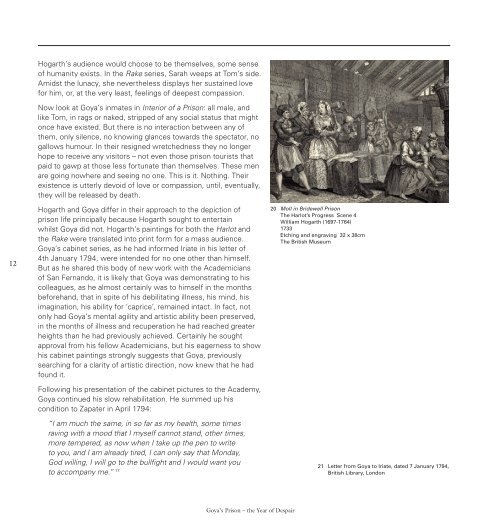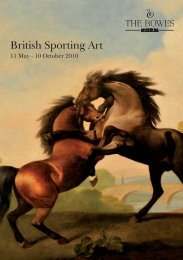Create successful ePaper yourself
Turn your PDF publications into a flip-book with our unique Google optimized e-Paper software.
12<br />
Hogarth’s audience would choose to be themselves, some sense<br />
of humanity exists. In the Rake series, Sarah weeps at Tom’s side.<br />
Amidst the lunacy, she nevertheless displays her sustained love<br />
for him, or, at the very least, feelings of deepest compassion.<br />
Now look at Goya’s inmates in Interior of a <strong>Prison</strong>: all male, and<br />
like Tom, in rags or naked, stripped of any social status that might<br />
once have existed. But there is no interaction between any of<br />
them, only silence, no knowing glances towards the spectator, no<br />
gallows humour. In their resigned wretchedness they no longer<br />
hope to receive any visitors – not even those prison tourists that<br />
paid to gawp at those less fortunate than themselves. These men<br />
are going nowhere and seeing no one. This is it. Nothing. Their<br />
existence is utterly devoid of love or compassion, until, eventually,<br />
they will be released by death.<br />
Hogarth and Goya differ in their approach to the depiction of<br />
prison life principally because Hogarth sought to entertain<br />
whilst Goya did not. Hogarth’s paintings for both the Harlot and<br />
the Rake were translated into print form for a mass audience.<br />
Goya’s cabinet series, as he had informed Iriate in his letter of<br />
4th January 1794, were intended for no one other than himself.<br />
But as he shared this body of new work with the Academicians<br />
of San Fernando, it is likely that Goya was demonstrating to his<br />
colleagues, as he almost certainly was to himself in the months<br />
beforehand, that in spite of his debilitating illness, his mind, his<br />
imagination, his ability for ‘caprice’, remained intact. In fact, not<br />
only had Goya’s mental agility and artistic ability been preserved,<br />
in the months of illness and recuperation he had reached greater<br />
heights than he had previously achieved. Certainly he sought<br />
approval from his fellow Academicians, but his eagerness to show<br />
his cabinet paintings strongly suggests that Goya, previously<br />
searching for a clarity of artistic direction, now knew that he had<br />
found it.<br />
Following his presentation of the cabinet pictures to the Academy,<br />
Goya continued his slow rehabilitation. He summed up his<br />
condition to Zapater in April 1794:<br />
“I am much the same, in so far as my health, some times<br />
raving with a mood that I myself cannot stand, other times,<br />
more tempered, as now when I take up the pen to write<br />
to you, and I am already tired, I can only say that Monday,<br />
God willing, I will go to the bullfight and I would want you<br />
to accompany me.” 17<br />
20 Moll in Bridewell <strong>Prison</strong><br />
The Harlot’s Progress Scene 4<br />
William Hogarth (1697-1764)<br />
1733<br />
Etching and engraving 32 x 38cm<br />
The British Museum<br />
21 Letter from Goya to Iriate, dated 7 January 1794,<br />
British Library, London<br />
Goya’s <strong>Prison</strong> – the Year of Despair






